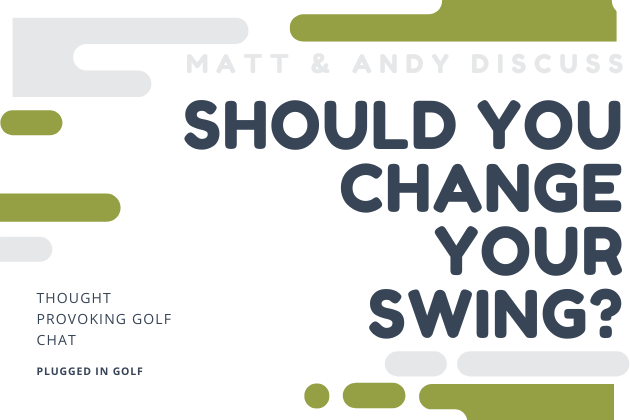
In this series, Matt and Andy discuss a golf topic they find interesting or important. This isn’t an interview or a debate, just a conversation that occurred over email so that it could be shared with you. If you like it, let us know in the comments. If there’s a question you’d like to see discussed, share that, too. Thanks.
MATT: To bookend our podcast about your personal swing changes [listen HERE], I thought we could do an email back and forth about the value of changing your swing for the average golfer. I’m excited to see where this goes.
I’ll start with this: I’ve been a longtime enemy of YouTube golf instruction and the golf magazine “tips” culture. I think I’m changing my view. Making real, big, fundamental changes to one’s golf swing is hard. It’s time consuming. It takes more effort and heartache than most people are willing to endure. So I don’t think most golfers should try to change their swings. I think that, to the extent they want to practice, they should work on skills [more on that HERE], and I think the little bite-sized tips are fine, because they might buy someone a few swings worth of happiness.
How has your recent experience with swing changes affected your view on teaching significant swing changes? Are you giving students a caveat that this might hurt and lead to some bad golf?
ANDY: I’ve had the crazy opportunity to spend time with Hank Haney, both watching him teach and having him give me a lesson. I saw immediate results in the lesson, and was able to hit certain shots I wasn’t able to before. I knew the changes were worth doing. It made it feel better and easier to hit a golf ball. From there I worked on what he gave me and also tried to incorporate a couple other things I had learned, specifically the new grip he showed Tiger. Come on, who wouldn’t want to have the same grip as Tiger?! I practiced a lot and was able to hit the ball great indoors on a TrackMan, but then had a lot of trouble when going outside. I had to do some work to find the “sweet spot” of how much change I could handle and still take it to the course.
At The Golf Practice we mostly work with people on a weekly or bi-weekly basis. It’s very common for someone to make some progress in a lesson, whether it’s skill improvement like being able to hit a different shot, or technical where they are able to change something in their mechanics, and then come back the next week and need to learn it all over again. Usually they pick it up much faster after having already learned it once. As a coach, I am very cognizant of giving my students the right coaching, and not overloading them with information. Since my swing changes, it has made me slow down a little bit, and make sure students have actually learned one concept before moving onto another. Everyone, myself included, thinks we can make more changes than we actually can, so I see it as part of my job to help students navigate this dilemma.

MATT: When you get a new student, how much time do you spend talking about their goals? And, relatedly, the amount of time and effort they’re willing to commit?
I think the former is the most underrated, under-asked question in golf lessons and club fitting. So many golfers want to “get better” and haven’t spent any time thinking about what that means. I think it’s a difficult question that people don’t grapple with enough before they start down various paths of “improvement.”
ANDY: I spend time at the beginning of our first session asking about their goals, how often they play and practice, and if they’ve worked on anything in the past. There’s a lot of similarities. Most people just want to get a little bit better, and reach the next scoring hurdle, i.e. breaking 90, 80, 70. And most people are working on or thinking about something in their swing that has nothing to do with their biggest impact fault.
Often what people are working on is making them worse. For example, a 5 handicap was struggling with chunking shots or hitting high on the club face. He was focusing on “rotation” in the down swing. This was keeping him from getting to his lead side, so when I coached him through not thinking about rotating and instead focus on finishing with his weight in his lead foot, he started hitting it much better very quickly.
I work on helping make students aware of what’s actually going on in their swing, help them understand what needs to be done, and give them a way to move forward. Sometimes this is done through changing their intention: right now it’s like you’re swinging toward third base, swing toward first base. Sometimes it’s through mechanics if something is so far “off” like a grip or club face position, that I don’t think they’d be able to get good results unless that is changed.

MATT: Let’s zoom out a bit and get away from your teaching practice and students. What percentage of golfers should be taking lessons and trying to change their swing? And what’s the reason for your answer?
ANDY: I think anyone who is serious about improving should take lessons. And this doesn’t necessarily mean changing your swing. A lot of people need help sifting through swing thoughts, tips from friends, and things they’ve seen on YouTube and TV. They need to understand what their unique tendencies are, and have a good plan to move forward. There are people who are members of country clubs, have spent thousands on a custom fit set of clubs, and yet when they are slicing they watch a couple of videos and think that will help- what are we doing here?
I know there’s definitely a financial and time commitment aspect to this question, so if someone can’t afford it, at least acknowledge that you’re doing this on your own and it will probably take longer than if you had someone helping you out. And, don’t try to make big changes based on a 10 minute YouTube video. A lot of golfers I meet spend tons of time and money on golf, but haven’t had lessons, and this confuses me.

MATT: We’ve finally found a point of discussion and disagreement, though I’ll ask a question first: what does it mean to be “serious about improving”?
Pending your definition, I disagree with your assertion. I think it is based on the instructors you work with and your own teaching, which, from everything you’ve stated so far, is very thoughtful and holistic. In my experience, there are a ton of bad golf instructors (in fairness to golf instructors, I think there are a ton of bad everything). I don’t think rolling up to your average golf course and asking for a lesson is going to yield good results. Most golf lessons I see could be taught by a robot: “This is your first lesson. I don’t need to ask questions. I will fix your grip. You will hate it because it’s uncomfortable, but you won’t argue because I’m the authority figure. You will express your disagreement by not coming back.” Hopefully you read that in a robot voice.
You seem to cite country club membership and custom fit clubs as a reason that players should take lessons, but I think that’s misguided. I enjoy golf equipment for its own sake, not because I’m under the delusion that it will turn me into a great player. If I were to ever join a private club (unlikely), it would be because I loved the course and the pace of play, not because I’m a more “serious” golfer than people who play at public courses.
I think a golf lesson CAN be a wonderful thing. A long term relationship with an instructor CAN be very helpful. But we live in a time of unprecedented access to information. If a golf instructor can’t or won’t explain to a player why they’re slicing, why shouldn’t the golfer click HERE so they can learn the physics of it? I think a lot of players would improve faster by reading a lesson on ball flight laws than having someone force them into a new takeaway procedure.
Finally, I think that the insistence on lessons overlooks another path of joy (for some): figuring it out yourself. I think it was on your podcast not long ago where someone was talking about Ben Hogan and how he practiced so much that he was constantly “figuring it out” and finding new keys, and that’s why he was so good. Obviously the average golfer doesn’t have Hogan’s talent or work ethic, but I think the same idea of finding little things to improve on can apply, and that might be more fun and beneficial than having someone else give you a set of answers which may or may not apply to the test you’re taking.
ANDY: There is a common “golfer archetype” I come across frequently. They want to get better, which means lowering their handicap. They play a ton. They use the internet for quick tips, rather than “information gathering” or “self learning.” And they are usually frustrated and don’t enjoy the game as much as I think they could. This is more the type of person I’m talking about.
The answer on whether to take lessons is indeed a fine line. I agree there are bad instructors, and so I would definitely not say to take lessons from bad teachers. I like your robot definition. Lots of instructors are former high level golfers who just couldn’t quite make it, so their way of saying around the game is to teach, whether or not they have a passion for it. You should be able to tell quickly if they truly want to help you, or if they just want to sound smart and spout information at you.
This is also getting at a bigger picture point on learning something new. I taught myself how to play guitar, and I am happy with my progress. If I wanted to learn guitar by myself, and complained all the time about my ability, well then I should probably go get some professional help or change my perspective. I may be arriving at a conclusion here, if you want to get better, get professional help, or have the right perspective on the situation. If you enjoy figuring it out yourself (this is actually the bucket I tend to fall into historically with my game) then stay on it! If you are struggling and keep trying YouTube and instagram, I think you’d benefit from finding a good coach. I found through a lesson with Haney that I had a couple of “blind spots” i.e. things I was doing in my swing that I didn’t realize were making things harder than they needed to be. I wasn’t able to see these on my own and found that allowing someone to give you another perspective can be very helpful.

MATT: That’s fair. I think what you’re describing is analogous to the club junkies in my world who buy to try, read a million reviews, but never get fit.
I think one of the problems that a lot of readers will have is, “How do I know if this instructor is good?” Paying to find out is an expensive proposition with lessons in our area being $100 and up, on average. Do you have a suggestion for weeding out the poor instructors?
Your guitar example is funny to me because I’m largely self-taught on guitar, too, and I go back and forth about lessons. I think it gives me more empathy toward “the average golfer” because my questions are theirs: Do I want to spend the money? Am I going to practice enough to make this worthwhile? How do I find a good instructor? How am I going to feel playing in front of someone else? All these questions lead me to a lot of YouTube (which has phenomenal guitar content) but no concerted plan for long term improvement.
ANDY: There’s a few things you can look for in finding a good instructor. Do you know anyone who’s worked with that person before? Do they have any reviews on Google? Do they typically do “one off” lessons, or work with people on a regular basis? You also don’t need to go in blind to the lesson, you should ask some questions in advance. Be able to describe your game, and the parts of it you are stuck on. Talk about what you’ve worked on, and how it’s gone for you. Ask if they have any ideas on where they would start, and how long they think it would take for you to get where you would like to go. Having a conversation and talking through these things will give you a sense on if it would be a good fit.
Ultimately, as we’ve discussed, the question on whether to take lessons has many factors. Money, time, goals, and much more. The biggest message I’m trying to convey is I see a lot of students who primarily work on their game through YouTube or Instagram, and in most cases it is making things worse, and not better. Their experience is quite similar: seeing some quick results, but then losing it and needing the next tip. So for anyone out there who feels stuck on this hamster wheel, lessons can be very beneficial. One of my favorite coaches, Michael Hebron, describes his role as being a “traffic cop for ideas,” and this person is much more needed in the age of unlimited information.
More from Matt & Andy
He founded Plugged In Golf in 2013 with the goal of helping all golfers play better and enjoy the game more.
Matt lives in the northwest suburbs of Chicago with his wife and two daughters.
- Performance Golf Click Stick Training Aid Review - October 18, 2024
- Callaway Opus Platinum Wedge Review - October 17, 2024
- When to Take a Break from Golf - October 15, 2024














4 Comments
What about Jim Hardy method of one plane and two plain they all or each have their own characteristics you can’t mix the two if you mix a tip for two plain into one plane it hurts your golf
I’m one Of those self taught with YouTube and at age 71 only wish this trove of info was available when I started at age 10.
Having two knee and one shoulder replacement I just can’t trust a coach to address my issues. Using about 6 YouTube coaches and a great camera setup in my garage I believe
I understand swing fundamentals and fully expect to get my 85 average into the high 70’s within a year (I’m in an odd race to shoot my age).
My two big tips, taking the time to understand the fundamentals can be very fulfilling. Second, what you feel during your swing and what you see on camera can be so drastically different. Thanks for your guidance and keep up the good work.
Unless someone is playing to his expectation, every time he swings the club he is making some change to get to his “expected” result. This is because the average golfer is always thinking about his game, whether on the range, the course or at work. And he is always thinking about what he can do to improve his swing, unless he is satisfied with his game. I don’t know anyone like that. Because as soon as a golfer hits a 7 iron 160 yards, he changes his expectation to 165 yards and changes his swing. That is why golf is a “thinking man’s game”.
I had an amateur coach try to change my swing when I was part of a driving range group. I almost destroyed my swing and motivation and almost gave me reason to stop golfing. This same coach also measured my clubs and said [ needed shorter clubs. My buddy Brad at Golf Town measured my hands to ground and reaffirmed that standard length was ideal. Another Golf Town associate helped me to just make a slight alignment adjustment. Look at how swing changes affected Tiger’s back issues.